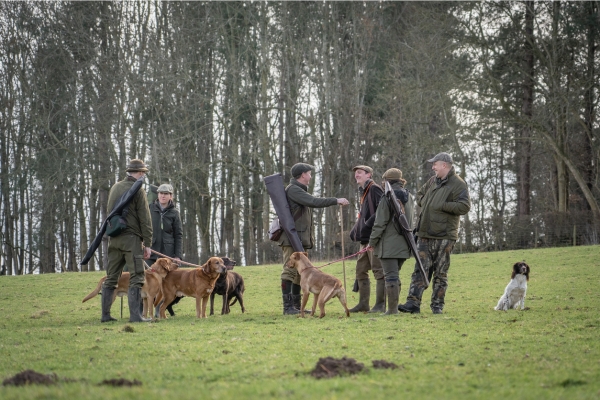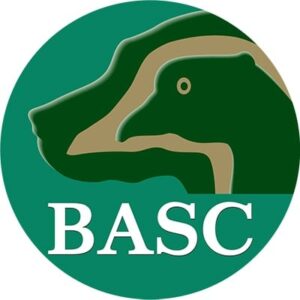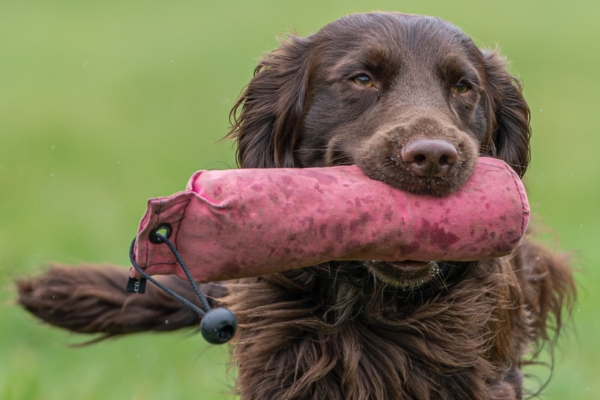
Have a beaters’ day to remember
BASC’s Julia Newman shares her top tips for enjoying your beaters’ day this year, a highlight in the shooting calendar for all involved.
Get information on the legal shooting season for mammals and birds in the UK.
Apply for funding for your project or make a donation today
Comprehensive information and advice from our specialist firearms team.
Everything you need to know about shotgun, rifle and airgun ammunition.
Find our up-to-date information, advice and links to government resources.
Everything you need to know on firearms law and licensing.
All the latest news and advice on general licences and how they affect you.


It is a pleasure to share the company of a dog when stalking deer, but our four-legged friends are far from nice-to-have accessories, says ROD GREENWOOD.
The beginnings of my passion for field sports can be traced back to when my father would drag me, sometimes literally, across the Cambridgeshire fens after the Trinity Foot Beagles. Ever since those cold and wet winter days in pursuit of hares, hound work and a dog’s reactions to scent have been of great interest to me.
Being able to read a dog’s behaviour is important in many of our country pursuits. Hares are reasonably easy to hunt, as they naturally run a left-handed circle; it was when they were getting tired that you had to concentrate on the hound work, to ensure they did not change scent lines and miss an opportunity. But different quarry requires a different approach.
Friends and colleagues who run small walked-up days on the moors and local lowland shoots, often comment on how many of the walking Guns cannot read a dog – in those cases it is usually a spaniel, retriever or pointer of sorts – thereby missing the opportunity to ready themselves for a shot at a pheasant, rabbit, woodcock or grouse. And then we have dogs for deer…
For many years hunters and stalkers have used dogs to help them. When stalking deer, it is a pleasure to be with a dog walking quietly at heel or, in some cases, slightly in front. Gaining the knowledge that the quarry is nearby can help you approach deer without disturbing them, improving the chances of a shot. And then, of course, our four-legged friends have a key role to play in the follow-up and recovery.

Many breeds of dog of varying sizes have been trained to work with deer. There are the specialist tracking hounds, such as the Bavarian mountain hound or the Hanoverian, but the larger breeds – think Labradors, German pointers or wire-haired vizslas – are particularly popular.
Many terrier breeds are also out there doing a good job – as are teckels. The eventual breed selected often reflects the individual stalker’s preference, requirements and domestic circumstances, such as kennel space, the species of deer stalked, and the terrain and type of stalking undertaken.
Puppies from known working stock and with a successful history of tracking deer are likely to be among the best candidates for training. And, as with any gundog, basic training is essential. I’ve found the best dogs tend to have a calm, confident and bold character. They require the ability to be reliable when recalled and when walking to heel, especially in the presence of deer, game and other livestock. There is no point having a gun-shy dog; they will become happier around a rifle shot when they realise the outcome, though. And they need to be happy left alone and remain quiet – possibly for extended periods and potentially out of sight of the handler – while the stalker makes the final approach for a shot or is sat in an enclosed high seat.
If their interest in deer can be encouraged, most dogs with some level of training should be perfectly capable of accompanying a stalker, helping to indicate the presence of live deer and, of course, finding shot (dead) deer. Further training will, however, be required for a dog to become efficient at tracking injured deer. More on that later…
It is generally recommended that a dog intended for working with deer is trained solely for that purpose from the outset. However, that wasn’t how things started for my old black Labrador Sage, who picked-up on mixed shoot days – retrieving pheasants, partridges and ducks – for the first 13 years of his life.
In his later years, when I stopped keepering and started teaching, Sage fell into the role of stalking pal. Occasionally he was used to follow up deer, particularly when they had run into thick cover at last light. Finding a lethally shot deer by ground or air scent was his main role, and having found many a gamebird and duck, his acute sense of smell was well attuned to the slightest drop of blood, so a chest shot deer proved easy for him.
To ensure my next dog, Sabbath, was able to join me stalking sooner rather than later, training commenced early with simple trails of fresh venison liver across the cottage’s back lawn. Within a few weeks the new dog was keen and showed great intensity when scenting the line left by the liver; he would audibly inhale through his nose.
As Sabbath has grown older and more competent, he has joined me on more outings and eventually learned to stalk with me at heel, which I now find greatly rewarding. To steady him, he does not always get to accompany me. He has sat at the base of a high seat and on more than one occasion alerted me to approaching or passing deer. He detects them using his nose, but I am sure on many occasions he has seen the animal, too. Looking down through the rungs of the high seat ladder and noting the wind direction, I watch his head movements and the intensity of his sniffing along with the height and angle of his head as he begins wagging his tail. It reminds me of my younger days again and some old texts written on beagling and hound work; one rule ends with the line “never give up while a hound will move his stern”.

It is astonishing how much you must learn to trust your dog. This may need some reinforcement through repeated experiences, but once you do have that trust, many more deer will be brought to your attention. Dogs will undoubtedly alert you to deer that are approaching or upwind of you. But you need to remember to glance down at the dog, taking your eyes away from your binoculars – or, nowadays, your thermal spotter!
You will need to work with the wind anyway while stalking, so the deer’s scent should hopefully be blowing in your general direction. This will aid the dog’s highly tuned olfactory senses.
When stalking, we tend to use dogs as scent hounds, relying predominantly on their noses – and this generally dictates the best breeds for the job. But there have been occasions that, due to his stature, Sabbath has physically seen under the canopy and the browse line and indicated the whereabouts of deer. A while ago he did exactly this while I was trying to outwit some fallow prickets one morning. I had almost given up on being successful, when suddenly he stepped boldly forward with his ears pricked and a fixed stare. I followed his line of sight and there, some 80 metres in front of us both, picking its way through the brash and sycamore saplings, was one of the fallow. Had it not been for Sabbath, I would have probably bumped that deer and left the wood that day without a shot.
Unfortunately, occasionally a shot is misplaced. It is then our responsibility to try to rectify that.
When beginning to track an injured or wounded deer, it is worth remembering that in most cases the shot deer will be found dead, hopefully on the spot or very close by. Sometimes, though, deer are wounded and the use of a dog can substantially increase the chance of finding the animal in these situations.
If a dog is required to track a wounded animal, it is paramount that you can read the dog’s body language. The ability to do so will come from your experience of watching the dog’s body movements while it works out a scent line. It might be that you have used scent shoes and some blood or you have watched the dog track a shot deer from the strike (the position of the deer when it was shot), to where it is laid dead. A good tracking dog will be able to differentiate a wounded animal’s scent line from the rest of a herd if needs be. This is where we must distinguish between dogs that can find a dead deer that has run on and died a hundred yards away, and dogs that will follow a cold trail much further after several hours.
It is not essential to have a dog capable of the latter with you when stalking, but all deer stalkers should have access to a suitable dog or be able to contact a dog and handler team. UK Deer Track & Recovery (UKDTR), set up by Tony Lowry, is one such voluntary service.
Presently UKDTR has 26 members volunteering across England with trained dogs capable of tracking mobile animals and following overnight (or older) trails. The group is in the process of setting up a new mentoring scheme to try to build its network of volunteers in areas such as East Anglia, Essex, Kent, Surrey, and Sussex.
It is crucial, whether you have a dog or seek the help of a tracking service, that you read the deer’s reaction to the shot and mark the position of the animal when the shot was taken. Investigation of the strike will then provide the information needed to follow up the deer in the appropriate manner. That may well mean marking the area and waiting for a specialist team to turn up. Contact details and useful, step-by-step advice for what to do when you do find yourself with a lost or wounded deer on your hands, can be found on the UKDTR website: ukdtr.co.uk
Having worked and stalked with Niels Sondergaard, I would highly recommend his book Working with Dogs for Deer.
Keep an eye out for BASC’s new deer stalking films – one of which focuses on follow-up and recovery – coming to YouTube in 2023.


BASC’s Julia Newman shares her top tips for enjoying your beaters’ day this year, a highlight in the shooting calendar for all involved.

The gundog world is uniting for the 5 Regions Charity Working Test, a national event created to raise awareness of mental health challenges in rural communities.

Following on from the Value of Shooting report earlier this year, John Bates remarks on the value he finds from being part of DIY shoot.
Sign up to our weekly newsletter and get all the latest updates straight to your inbox.
© 2025 British Association for Shooting and Conservation. Registered Office: Marford Mill, Rossett, Wrexham, LL12 0HL – Registered Society No: 28488R. BASC is a trading name of the British Association for Shooting and Conservation Limited which is authorised and regulated by the Financial Conduct Authority (FCA) under firm reference number 311937.
BASC Direct Ltd is an Introducer Appointed Representative of Agria Pet Insurance Ltd who administer the insurance and is authorised and regulated by the Financial Conduct Authority, Financial Services Register Number 496160. Agria Pet Insurance is registered and incorporated in England and Wales with registered number 04258783. Registered office: First Floor, Blue Leanie, Walton Street, Aylesbury, Buckinghamshire, HP21 7QW. Agria insurance policies are underwritten by Agria Försäkring.
If you have any questions or complaints about your BASC membership insurance cover, please email us. More information about resolving complaints can be found on the FCA website or on the EU ODR platform.